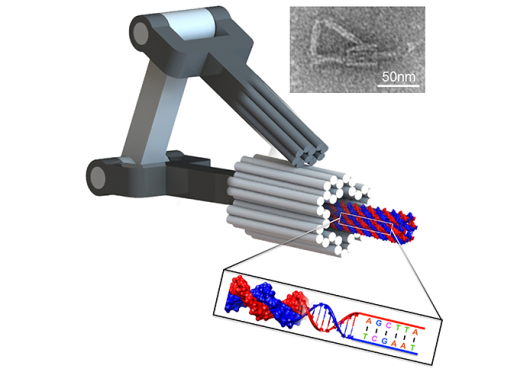
A movable machine researchers Carlos Castro and Haijun Su made with ‘DNA oragami’ at OSU that they said could be a building block for future experiments. Credit: Courtesy of Alexander Marras
When Carlos Castro and Haijun Su started working as assistant professors in the engineering department at Ohio State, they didn’t know that just a few years later, they would be creating what some are calling “real life ‘Transformers.’”
Castro approached Su with an idea of combining DNA and nanotechology, and by late 2011, the two paired up and began working on turning their idea into a reality.
“We have formed a critical team in the traditional machine elements, and Carlos has the DNA origami expertise so we can form a perfect team,” Su said.
Su and Castro, who both have backgrounds in mechanical engineering, combined their knowledge of robotics and nanotechnology to use DNA origami, which is the folding of DNA on a nanoscale, to create nanorobots that can change shape as well as repeatedly perform a task.
The nanorobots Su and Castro are creating are changing what Su called “mostly static structures” into movable machines.
“This research is about designing multiple pieces and then assembling them into machines that have controllable motions,” Su said.
Su said these nanorobots are being called “DNA transformers” because of their ability to change shape. These advances in DNA origami could lead to breakthroughs in the treatment of major medical diseases such as cancer. They could allow for doctors to control not only how much but where in the body medications can be delivered, Su said.
Castro and Su’s work is funded by the National Science Foundation and has been published in the scientific journal Proceedings of the National Academy of Sciences.
Although Su said being published and having his work recognized is a great feeling, he added that the path to publication for him and Castro was a difficult one.
Su said even though he and Castro were originally ready to publish their findings in early 2013, they found it challenging to get their work published because neither of them had any previous published work and they were only assistant professors with no senior author.
“Carlos (and I) weren’t established … and we recognized that,” he said.
To overcome the challenges of getting published, Su and Castro decided to wait and publish their research, and they took that time to build up their individual resumes. After two years, they had done enough to have their DNA origami research published.
Alexander Marras and Lifeng Zhou are both graduate students in the College of Engineering who joined the project three years ago to help Castro and Su in their research.
Marras was finishing his undergraduate degree when he was first introduced to the project by one of his professors, who then put him in contact with Castro. Marras was so interested in the research he decided to apply to graduate school at OSU and work on the research with Castro and Su.
“I thought it was pretty fascinating. I always enjoyed mechanics and the design aspects of mechanical engineering,” Marras said. “And I think biology and the way the body works is just amazing, so when I learned about an opportunity to combine those and be involved in this brand new technology, I decided to apply to Ohio State for grad school.”
Both Marras and Zhou said they are excited about the possibilities of the study, and have many ideas on what the future holds for the research.
“It will help researchers build custom machines in the future that can serve specific purposes like trapping a molecule, generating forces in response to a bio signal or performing tasks on a cell surface,” Marras said. “The exciting thing is that it’s all really new and there are many different ways we can expand.”
Zhou said he thinks the research “will provide tools or devices that can function as robots to do work not only in blood vessels but also in cells. It can help people to treat lots of diseases, such as cancer.”
Each researcher sees the future of their research being extremely beneficial — not only for medical advancements, but also for the understanding of the relationship between DNA and mechanical engineering.
Su said the possibilities are numerous for the future of the research.
“With this paper we are building the building blocks, the building blocks are the joints … We are building a library of building blocks, and that opens the door. We can use these building blocks to construct any kind of machine.”

